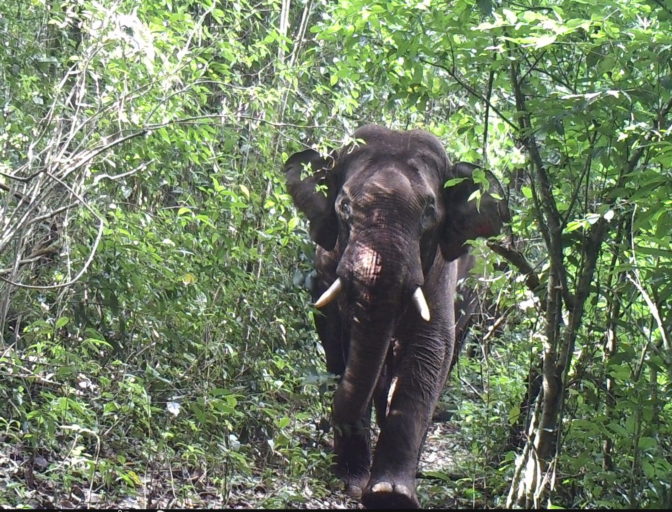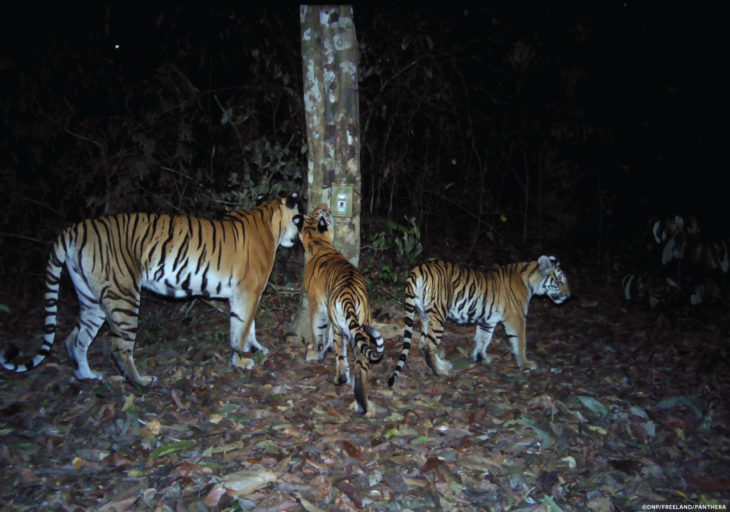Survey of previously inaccessible region of Myanmar reveals many endangered species
The first-ever surveys of forests in Karen state in southeast Myanmar — a region that was previously out-of-bounds for scientists due to security and political reasons — has yielded surprising results.
Researchers have recorded at least 31 species of mammals in the region, more than half of which are categorized as Near Threatened, Vulnerable or Endangered on the IUCN Red List, according to a study published in Oryx. Some of these endangered mammals include tigers (Panthera tigris), Asian elephants (Elephas maximus), Phayre’s langurs (Trachypithecus phayrei), and dholes (Cuon alpinus). Read more here.

Asian elephant captured by a camera trap. Image copyright KWCI.
A tiny, critically endangered tree frog still thrives in Hong Kong
Romer’s tree frog is, in every respect, an animal that keeps out of the way. Averaging just 1.5 to 2.5 centimeters (0.6 to 1 inches) in length, the tiny brown frog isn’t just the smallest frog living inside the territory of Hong Kong, but it’s also among the smallest in the world.
It is, in short, not the sort of animal that you would expect to make a big fuss. But the Romer’s tree frog inhabits an urban wilderness that has been part of the biggest spike in human population in history. Read more about them here.

A Romer’s tree frog crouches on club moss, showing its distinctive back markings. Photo courtesy of Kadoorie Farm and Botanic Garden
World’s second breeding population of Indochinese tigers discovered in Thailand’s forests
Conservationists in Thailand and the country’s Department of National Parks, Wildlife and Plant Conservation have released scientific findings that confirm the existence of the world’s second breeding population of Indochinese tigers, and provided the first photographic evidence of tiger cubs in Thailand’s Eastern Forest Complex. While the scientific data suggests an exceptionally low tiger density — on par with some of the most threatened tiger habitats in the world — the findings, “demonstrate the species’ remarkable resilience given wildlife poaching and illegal rosewood logging present in the Complex,” the statement said. Read about this discovery here.

A trio of tigers, a mother and her two cubs, inspect one of 156 camera traps placed by Thailand’s Department of National Parks (DNP), Freeland, and Panthera. Image courtesy of DNP/Freeland/Panthera.
Breakthrough boosts hope for treating contagious cancer in Tasmanian devils
A type of transmissible cancer has decimated Tasmanian devil (Sarcophilus harrisii) populations. First detected in 1996, the devil facial tumor disease (DFTD) has spread across most of the Tasmanian devil’s range and has wiped out more than 80 percent of these animals in Tasmania. The cancer, which spreads when the devils bite each other’s snouts, kills virtually every devil it infects. But researchers have found that Tasmanian devils have been evolving resistance to fight the cancer, so scientists may have a cure that could prevent the species’ extinction. Here’s the full story.

Tasmanian devil (Sarcophilus harrisii). Photo by JJ Harrison, Wikimedia Commons.
Andean cat captivates conservationists
Only 1,378 Andean cats (Leopardus jacobita) are thought to exist, with the small cats scattered over more than 150,000 square kilometers (roughly 600,000 square miles) of highlands from northeastern Peru to Patagonia, according to the first population numbers published last year on the IUCN red list.
But when an Andean cat suddenly showed up in the middle of a soccer field in Bolivia, conservationists saw an opportunity to learn much about this species. Read about what they learned by GPS-collaring this captivating cat here.

Until now, photo traps have provided much of the current information we have about Andean cats. Photo courtesy of Andean Cat Alliance
New population of rare Dryas monkey videotaped for the first time
Using remote cameras attached high up in trees and in the understory, researchers have captured the first ever video footage of a new population of the rare Dryas monkeys (Cercopithecus dryas) in the Democratic Republic of Congo (DRC) in Central Africa. The new population was found near the Lomami National Park in the DRC.
For a long time, the elusive Dryas monkey was believed to exist only in the Wamba-Kokolopori forest in central DRC. Head here to learn more about the discovery.

Fewer than 200 Dryas monkeys are believed to survive in the wild. Photo/Video Credit: Daniel Alempijevic, FAU Primate Evolution and Conservation Lab.
Plans for a bridge in a critical wildlife area in Borneo canceled
Controversial plans to build a bridge over the Kinabatangan River in Malaysian Borneo’s Sabah state have been canceled, announced Sabah Forest Department Chief Conservator Sam Mannan. “We are not going ahead with the bridge,” Mannan said. “In making this decision, Chief Minister of Sabah Datuk Seri Musa Aman has taken into consideration all the concerns and opinions expressed related to the bridge, including those from Yayasan Sime Darby, Nestle, scientists and NGO groups and also the opinion of someone who knows the territory better than anybody else – Sir David Attenborough.”
Conservationists argued that the bridge’s construction would tear apart habitat for endangered elephants, primates and birds in the Lower Kinabatangan Wildlife Sanctuary, a patchwork of protected areas that runs along its namesake river. The paved road would have run directly through part of the sanctuary. Read on here for more on this move and the area it now protects.

Six young orangutans. Photo courtesy Bjorn Vaugn / BOSF / Greenpeace
A superhighway changes course in Nigeria, sparing core forest area critical to elephants, great apes, people, and more
The path of a major highway project in eastern Nigeria has been altered in response to concerns from local and international groups about its impact on wildlife and communities. NGOs and scientific organizations have campaigned against the construction of a six-lane, 260-kilometer (162-mile) Cross River Highway because it cut through Nigeria’s Cross River National Park, which provides important habitat for IUCN Red List species and subspecies such as forest elephants (Loxodonta cyclotis), drills (Mandrillus leucophaeus) and Nigeria-Cameroon chimpanzees (Pan troglodytes ellioti). Identified as a biodiversity hotspot, the park also serves as the one of the last refuges for the roughly 300 remaining Cross River gorilla (Gorilla gorilla diehli).
The new highway route has been moved to the fringes of the national park, and while that plan has its own problems, it’s good news for biodiversity and endangered species that it will no longer run through the park’s core area. Learn more about the plan and the epic struggle to change it here.

Drills are related to baboons and mandrils. Photo taken at Limbe Wildlife Centre in Cameroon by John C. Cannon.
Rwanda welcomes 20 black rhinos to Akagera National Park
The reintroduction will bring the eastern black rhinos (Diceros bicornis michaeli), a subspecies of the IUCN-listed Critically Endangered black rhinoceros (Diceros bicornis), back to the savannas of Akagera National Park in the eastern part of the African country. There are around 1,000 eastern black rhinos left, according to African Parks, most of which live in Kenya. “The rhino’s return to this country … is a testament to Rwanda’s extraordinary commitment to conservation and is another milestone in the restoration of Akagera’s natural diversity,” said Peter Fearnhead, the CEO of the nonprofit organization African Parks. Read on here.

Female black rhino. Photo by Rhett Butler.
Saving the most endangered plants in the world: cycads
Cycads are believed to be the world’s oldest seed bearing plants, some dating back almost 300 million years. This makes them as old (or even older) than dinosaurs. This ancient group of plants is heavily sought after by collectors, though, and they frequently fall prey to poachers. In 2014, for instance, thieves reportedly stole 24 cycads — 22 of which are listed as critically endangered on the IUCN Red list — from the Kirstenbosch National Botanical Garden in Cape Town, South Africa. Here is a conversation we recently had with a researcher working with these plants about what is being done to bring them back.

All species of Encephalartos cycads, native to Africa, are believed to be at high risk of extinction. Photo courtesy of California Academy of Sciences.
Creative Commons BY-NC-ND